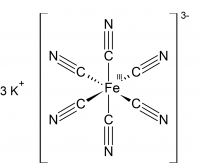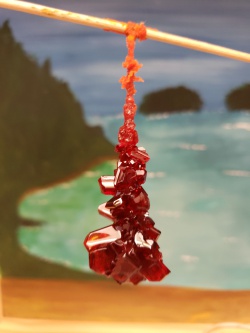Ferricyanide Crystal
Structure
The structure of potassium ferricyanide consists of an iron molecule octahedrally coordinated by six cyanide ligands.
General Information
- Molecular Weight: 329.24 g/mol
- Appearance: Red crystalline solid
- Melting Point: 300°C
- Density: 1.89 g/cm3
- Crystal Structure: Monoclinic
Safety
- When exposed to HCl, potassium ferricyanide forms hydrogen cyanide gas which is an asphyxiant and can be fatal.
- Potassium ferricyanide is not very toxic, but can stain.
General Procedure
Materials Needed
- Potassium Ferricyanide
- Water
- Beaker or other container
- Hot plate or stove
- Stir rod or spoon(non food grade)
- filter(not necessary)
Procedure
The most general way to grow a crystal includes forming a supersaturated solution by heating up water and adding in the crystal medium, here I used Potassium Ferricyanide, until is doesn't dissolve anymore.
For a general procedure, the following link can be used: How to Grow a Potassium Ferricyanide Crystal
The following is the procedure that I followed:
- Obtain potassium ferricyanide, a 250 mL beaker, a stirplate/hotplate, and a stirbar.
- Begin heating up the water on the hotplate and add the stirbar.
- Once hot, begin adding the potassium ferricyanide (It will take some time for it to dissolve, but it eventually will).
- Keep adding until the rate of dissolution decreases( The article above mentions to use about 93g in 200mL of water).
- Cover the finished solution with something(a watchglass or parafilm) and let it sit overnight.
Note: Another way to do this would be to make a saturated solution and allow the water to evaporate slowly over time. This may yield a single large crystal instead of a conglomerate of smaller crystals, although it will take significantly longer.

